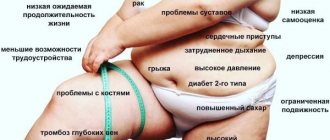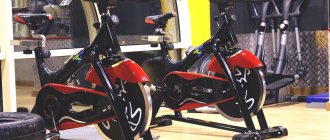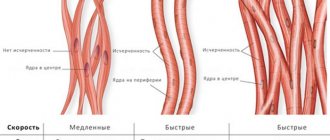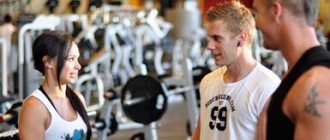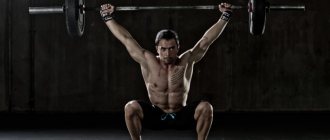Before you start losing weight, a beginner should know that it is impossible to transfer fat into muscle. This means that if a person is overweight, then when he starts working out in the gym, he will not achieve the effect of muscle accumulation and fat breakdown.
In other words, in order to remove fat tissue, you need to use some processes, and in order to build muscle, others.
We recommend reading: Pull-up corner
If the goal is to lose weight and get pumped up, you won’t be able to do it at the same time. It is impossible to drive one cell into another, as some people think. First you need to lose weight by losing excess weight, and only then build muscle.
Wraps, massages, rubbing will not help you lose fat mass. Fat from the triglycerides in which it is found in the body will be broken down into fatty acids and glycerol will enter the bloodstream. But if you don’t use it, for example, don’t give physical activity or don’t reduce calorie intake, these cells will return to their original place, accumulating on the sides. They can also deposit plaques on blood vessels in the form of cholesterol.
Eating right is very important
You can only get rid of excess fat if you eat right. This is exactly what a beginner who has decided to say goodbye to extra pounds should know. To do this, you can play sports, run, jump, swim, that is, do cardio exercises, but only slowly and for more than an hour at a time. You should train every other day. This will be enough, but if problems with obesity are serious, then it is better to exercise every day.
Having lost the hated kilograms, you can move on to gaining muscle mass. Then, perhaps, the kilograms will return, but the person’s body will look many times more beautiful. It will become slim and fit
To lose fat and gain muscle, you need to eat differently. In the first case, the amount of carbohydrates should be reduced to a minimum or completely abandoned for some time. In the second case, you should eat a limited amount of carbohydrates in the first half of the day, and increase your protein intake in the second half of the day. The general thing is that you need to eat little by little and in fractions.
Important! Only by knowing what 1 kg of fat and 1 kg of muscle looks like can you build up the former and fight the latter.
We recommend reading: Extension of arms on a block with a rope
Human Fat Density and Muscle Density
Muscle has a higher density than fat. It turns out that greater density occupies a smaller volume of the same weight than less density, and a person who has a lot of muscle tissue looks slimmer and prettier. And this despite the fact that they will have the same weight.
Important! It is wrong to think that a woman weighing 60 kilograms, living without exercise and being overweight, will look fatter than a pumped one.
It has been proven that fat density is 0.9 and muscle density is 1.06 grams per cubic centimeter. It turns out that the difference between them is small. It is only 15 percent and it is difficult to visually notice the difference. That is, both girls weighing 60 kilograms - one fat, the other pumped up - will look approximately the same. The only difference is that one of them has visible muscle relief.
Important! It is easier for a person who has a lot of muscles to lose weight.
It is possible to understand the truth that fat density and muscle density have little difference through experiment. You need to take meat and lard, which look the same in volume, and if you weigh them, it turns out that the meat weighs 99 grams, and the lard is only 98.
It is easier for a person who has a lot of muscles to lose weight
The following conclusions suggest themselves:
- It is not true that fat takes up ten times more space than muscle.
- Muscles grow unevenly during training. Mostly where they are being worked on. Adipose tissue is distributed evenly in particularly vulnerable areas. In men in the abdominal area, in women on the buttocks, thighs, and abdomen.
Nutrition for gaining muscle mass
The first step to gaining muscle mass is for an athlete to determine his body type. There are three types in total:
- Ectomorph (thin body type);
- Mesomorph (the most comfortable type for a sculpted physique);
- Endomorph (prone to rapid weight gain).
The second step will be the nutrition plan itself. Yes, beauty requires great sacrifice and energy expenditure. Depending on what type the future “Apollo” belongs to, the athlete’s entire regime will be structured.
First of all, it is important to understand that to gain weight you will need a good appetite. Without a surplus, it will not be possible to collect housing and communal services
And given that exercises that promote muscle growth are very energy-intensive, you will have to eat a lot.
Typically, trainers advise eating 5-6 times a day. Such nutrition will allow you to quickly gain the required muscle volume. But you should be prepared for the fact that soon after such daily “stomach holidays” you will have to tighten the belt considerably. This is necessary in order to lose excess fat that accumulates along with muscle mass.
To lose weight you will have to slightly cut back on your diet. It is necessary to reduce the intake of carbohydrates and fats into the body, while simultaneously creating a calorie deficit. Such nutrition will quickly bring the percentage of fat in the body back to normal, showing everyone around the pleasant relief of a pumped-up body.
Fat or weightlifter?
You can often find a common example in the comparison of fat and muscle: a well-fed person can weigh 100 kg and not look very beautiful, and a bodybuilder who also weighs 100 kg, but has a low percentage of fat, nevertheless looks quite aesthetically pleasing. Same weight, but different shape. In the first case, the person will seem much larger in size than the second, but meanwhile they have the same weight, so what is the mystery?
Having understood the question “Which is heavier: muscles or fat in a person,” everyone can clearly understand what actions they need to take depending on their goal of building a figure. After all, only having certain knowledge in a certain matter can you competently approach solving a problem.
We recommend reading: Leg extension in a block
Functions of fat deposits
Fat is not a useless phenomenon; its critical level poses a threat to health, so you need to take a responsible approach to the process of losing weight. Layers of fat protect internal organs and create an additional source of heat in cold weather, which explains the decrease in metabolism in winter as the body tries to conserve fat reserves.
Having learned the answer to the question “fat or muscle - which is heavier”, many try in every way to get rid of fat, which exceeds muscle tissue in volume, but it is worth understanding that there is a limit beyond which it is not advisable to go.
The lowest threshold for a woman’s fat level is 12%, after which problems with both appearance and feminine appearance may begin. Men can feel great with 5% body fat.
However, a high percentage of fat is harmful to the body, since the likelihood of developing diabetes increases, energy decreases, metabolism slows down, and lethargy sets in.
Fat in women and men
As you know, women and men are built completely differently. Including, fat deposition in female and male bodies occurs differently.
In women, fat is usually stored on the thighs. Its function is to save energy for the lactation period and ensure the feeding of the baby. This fat is very difficult to lose. And during breastfeeding, it becomes more pliable and comes off easier.
In men, fat is deposited mostly in the abdominal area. Men generally have a much easier time losing weight than women.
It is also important that the latter are much more impressionable than men and are very sensitive to their bodies. The girl will quickly notice the extra kilogram on her body.
Men don’t worry at all about how a kilogram of fat looks on their body. Moreover, they often do not see changes in their body even by ten kilograms.
For clarity, you can go back and remember what 1 kg of fat looks like. The photo is presented above in the article.
This volume is in spoons, glasses, jars, etc.
Please note that the weight is calculated based on the volume of the containers and we do not in any way guarantee that they contain the specified volume, however, for approximate measurements in everyday life, the calculated weight is quite applicable.
To determine a more accurate weight, you should use a scale!
Also, keep in mind that some substances can have a destructive effect on the indicated containers and cannot be contained in them in real life.
It often happens that a well-fed person weighs one hundred kilograms, and a bodybuilder - fit and pumped up - also weighs one hundred kilograms. At the same time, the first man does not look very aesthetically pleasing with a hanging belly, but the second one looks beautiful. These people have the same weight, but different shapes. The mystery lies in the fact that fat and muscle do not weigh the same.
Be careful with carbohydrates
The content of carbohydrates in the diet also influences the adequate reduction of body fat and preservation of muscles Excessive consumption of carbohydrates contributes to their conversion into fat and storage in the body, but a sharp reduction in carbohydrate consumption is also not the right solution . Excessively low carbohydrate intake is not necessary for weight loss, as it can lead to uneven muscle tissue retention and decreased performance during training. A 2003 study confirmed the effect of carbohydrates on reducing fat percentage and preserving muscle. Participants followed a 10-week plan during which they consumed 1,700 calories per day . They were divided into two groups, the first of which consumed carbohydrates and protein in a 1.4:1 ratio , for example, 125 g protein and 171 g carbohydrates . The second group consumed 3.5 times more carbohydrates relative to protein , which is approximately 437.5 g of carbohydrates and 125 g of protein . The results showed that the first group lost more fat and less muscle mass than the second. [8]
Calculate your ideal sports weight!
You can also achieve the desired result using a less complex ratio. The ideal ratio of carbohydrates to protein for preserving muscle and reducing fat percentage is 2:1 . For example, with a daily intake of 125 g of protein, the amount of carbohydrates is 250 g . in certain cases , namely for athletes and people who train hard, but is not important for the average person. Determining the ideal time to burn fat is difficult because research results vary so much . During the day, it is important to take carbohydrates in the morning to provide energy for daily activities and after exercise to replenish energy and nutrients . The most important factor is the source of carbohydrates , so complex carbohydrates containing fiber , such as oatmeal, are preferred. Your overall carbohydrate intake is more important than the exact timing of your carbohydrate intake unless you are training for a competition. If you eat carbohydrates in moderation, you don't have to worry about timing them. [8] [2] [14] Looking for the perfect breakfast dish to fill up your carbs and protein ? 15 grams of protein and 53 grams of carbohydrates this instant oatmeal is an excellent choice.
Nutrition for gaining muscle mass
How much does a torneo treadmill weigh?
The first step to gaining muscle mass is for an athlete to determine his body type. There are three types in total:
- Ectomorph (thin body type);
- Mesomorph (the most comfortable type for a sculpted physique);
- Endomorph (prone to rapid weight gain).
The second step will be the nutrition plan itself. Yes, beauty requires great sacrifice and energy expenditure. Depending on what type the future “Apollo” belongs to, the athlete’s entire regime will be structured.
First of all, it is important to understand that to gain weight you will need a good appetite. Without a surplus, it will not be possible to collect housing and communal services
And given that exercises that promote muscle growth are very energy-intensive, you will have to eat a lot.
Typically, trainers advise eating 5-6 times a day. Such nutrition will allow you to quickly gain the required muscle volume. But you should be prepared for the fact that soon after such daily “stomach holidays” you will have to tighten the belt considerably. This is necessary in order to lose excess fat that accumulates along with muscle mass.
To lose weight you will have to slightly cut back on your diet. It is necessary to reduce the intake of carbohydrates and fats into the body, while simultaneously creating a calorie deficit. Such nutrition will quickly bring the percentage of fat in the body back to normal, showing everyone around the pleasant relief of a pumped-up body.
Muscle is heavier than fat or not, as indicated by body fat percentage
An excess amount of adipose tissue in the body of any person not only makes his figure unaesthetic, but also threatens with dangerous diseases. Our article today is not about this, but about the ratio of muscle mass and fat. You've probably heard the statement that muscle is heavier than fat. This is true, but there is not such a huge difference between the volumes of fat and muscle, as is usually shown in photographs and pictures.
So, we will help you thoroughly understand what is heavier - muscles or fat, we will analyze specific numbers and tell you how voluminous fat mass is replaced by heavier muscles.
Understanding Fat and Muscle Mass
Overweight people who start exercising to lose weight sometimes get upset when they look at the numbers on the scale. At the same time, they don’t understand why the body weight remains the same, but the figure becomes slimmer? Everything is explained very simply. Heavy weight training and cardio exercises to burn fat burn calories, and along with this, an increase in muscle mass occurs. At first, for beginners who take up sports, their muscles grow quite quickly thanks to new physical exercises.
It turns out that muscle tissue grows and the percentage of fat decreases, but at the same time the scale arrow stays the same or even shifts upward. This is due to the fact that a kilogram of muscle is not as voluminous as the same amount of fat. When training regularly, it is better to weigh yourself not every day, but once every 2-4 weeks, but in any case, weight should not be the main criterion for assessing results. Take body measurements once a month and focus on them, and also look at your reflection in the mirror.
Slowly but surely, fat loss and muscle growth will occur, and your body will transform. Muscle is definitely heavier than fat, so two people of the same height and weight can look different if one plays sports and is in good physical shape and the other has a lot of excess fat.
Why is muscle heavier than fat?
How much heavier muscle is than fat can be determined by its density. There are pictures on the Internet that clearly demonstrate how many times muscle tissue is heavier than fat. Usually this difference is amazing - a kilogram of fat is 4-5 times larger than the same amount of muscle. In fact, everything is greatly exaggerated.
Muscle tissue does weigh more than fat tissue, but not significantly. How much muscle is heavier than fat becomes clear in numbers:
- muscle density – 1.3 g per centimeter;
- The density of fat in the human body is about 0.9 g per centimeter.
Accordingly, fat weighs about one and a half times less than muscle. The difference is noticeable, but not as significant as many people think. So it turns out that if you started training, and the weight according to the scales remains the same, perhaps you are simply building muscle while burning calories. At the same time, body volumes remain almost unchanged or even decrease.
Because muscle weighs more than fat, women and men lose their figures over the years if they don't exercise. The fact is that the body weight of 45-50 years old may be the same as at 20-25 years old, but the build will be radically different. In youth, muscles predominate, and over the years, adipose tissue begins to grow, and it is always more difficult for mature people to burn fat.
Many people are mistaken that proper training can turn fat into muscle. This is a grave mistake. The fact is that fat and muscle are built in the body according to completely different principles. When playing sports, the level of fat gradually decreases, and muscles grow - these are two separate physiological processes, since the tissues have a different structure and structure.
How are fat and muscle redistributed?
To the question of how much heavier muscles are than fat in the human body, we answered you in detail, but to complete the picture, let’s look at the redistribution of these tissues in the body. It is impossible to say exactly how much muscle and fat should be in the body of a man or woman. Every body contains an amount of water, and people have different lifestyles and metabolisms. Be that as it may, a thick layer of fat is not necessary, but a deficiency of fat is also harmful. Moreover, a low percentage of body fat is especially dangerous for women.
A mistake is made by people who go on low-calorie mono-diets without exercising. The body begins to destroy muscles on its own, since it is the muscles that consume calories. It turns out that the smaller the muscles, the fewer calories are needed for their work. When the diet is completed, the body will return to its original weight, but this will be achieved by storing body fat rather than muscle. Muscles simply cannot grow without exercise.
Since fat weighs lighter than muscle tissue, after some time after the diet you may notice the opposite effect: your body will gain weight, and your figure will become even less attractive! Walking or even jogging in the park will not correct the situation, since the body needs muscles to burn fat. Only proper strength training can pump them up.
Why doesn't the weight change?
Due to the difference in the weight of muscle and fat, when losing weight, your weight may stay the same. In the process of sports activity, both fat is burned and muscle mass is built. Due to the fact that the proportion of body fat may be lower than the proportion of muscle, the effect of stagnant weight change can be created. In other words, two processes occurred simultaneously - fat went away and muscles increased.
Based on this, you should not attach great importance to the numbers on the scales. Visually you can see changes, a decrease in volume in certain areas, but remain at the same weight.
Many people believe that if they work out in the gym, their figure will in any case become athletic, whether they initially have fat or muscles. What is harder - burning lipids or increasing lean mass?
You need to understand that fat does not transfer to muscle. Intense exercise, of course, reduces body fat in a sense, but good results can only be achieved by limiting carbohydrates.
Padmasana (lotus pose)
It is believed that Padmasana is the best pose for both meditation and relaxation and breathing practices. However, to actually sit in the lotus position requires years of training. Therefore, various breathing practices are most often done in a cross-legged pose. So, sit down in any position that is comfortable for you with your legs crossed and master breathing techniques.

